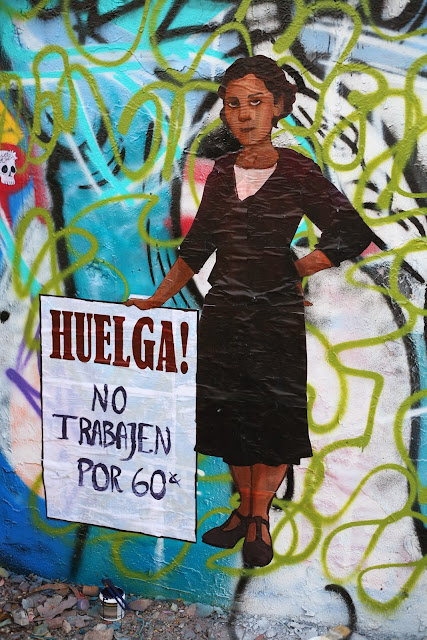I ultimately settled on wheatpaste over a mural or a traditional painting on canvas for several reasons. First of all, my goal is not to further confine Tenayuca to the past, but bring her and her work forward to be recognized in the present. The two works commemorating her that I discussed in this post- the monument and the children's book- while they are important, still confine her to the past. They instead celebrate her life, calling her achievements victories without recognition that the same issues she fought continue today on a large scale.
By placing Tenayuca in the public eye among a modern art form, I hope to create a parallel between the work in her past and the work that is being done by activists today. I will not block out a section for her figure among the graffiti in the background, as one would do in a mural, but paste her figure directly onto the painting so she is imposed over the background rather than separated from it by a barrier that I create.
The location and medium that I have chosen hold significance not only in their availability to the public, but also in the history of graffiti and street art. Both of these forms, particularly graffiti, are inseparable form themes of poverty, unemployment, and capitalism. Aerosol graffiti was born in New York City in the late 70's/ early 80's. In many ways, graffiti was a creative response to a repressive and neglected environment. In a city where young people saw their neighborhoods left to deteriorate, the response was to reclaim public space through art.
This deterioration and neglect is directly linked to Tenayuca's work through capitalism. Capitalism is a powerful force in modern society, a force which ate up public space in New York City and beyond, and a system which, in its modern form, thrives off of unemployment and exploited labor. When there is a pool of unemployed labor sitting in the inner city, a minimum wage worker has very little bargaining power because his or her employer sees that person as disposable. Tenayuca was dealing with this very situation: exploited labor.
With all this in mind, I ultimately hope to continue this project on my own time, expanding it and making its message more and more relevant to modern society. Soon in the future, I plan to go back to the graffiti wall with not one but a whole series of images of Tenayuca, each with a different sign relating to modern labor struggles. The examples are numerous. Even just over the last year, my own university has seen backlash against its plans to privatize university services that would result in job loss for many custodial and food service workers. More recently, fast food employees have been protesting or going on strike across the country. Debates over minimum wage increases rage on, and Walmart hosts a food drive for the employees who they pay too little to afford enough for Thanksgiving.
Tenayuca's work is still highly relevant.


















